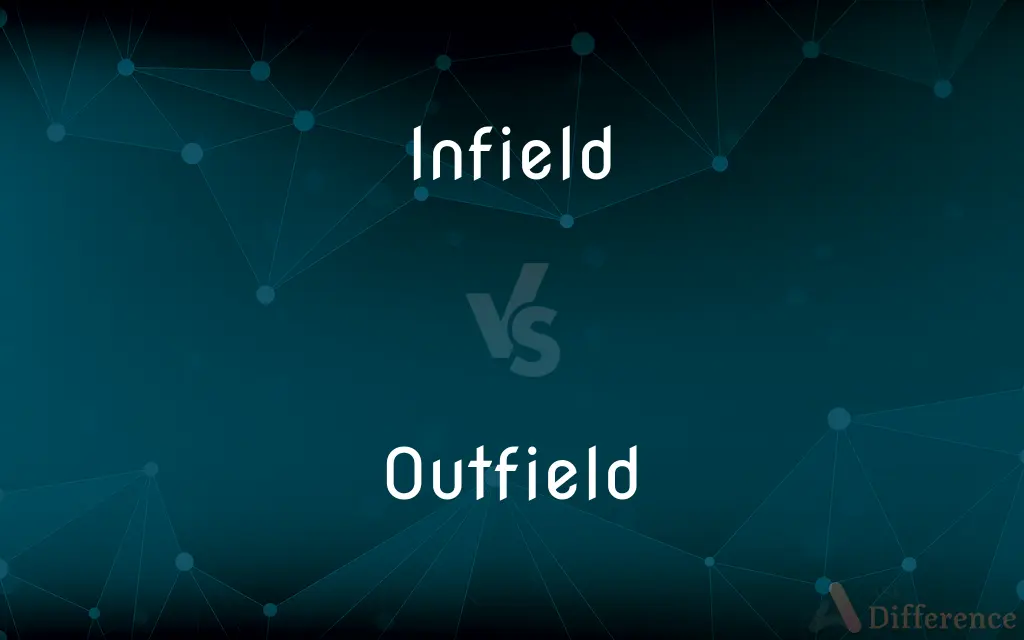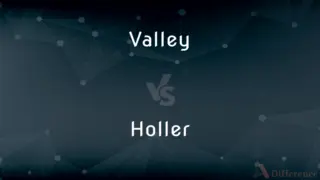Infield vs. Outfield — What's the Difference?
Edited by Tayyaba Rehman — By Urooj Arif — Updated on March 21, 2024
Infield refers to the area within the bases of a baseball or softball field, focusing on quick, close plays; outfield covers the area beyond the bases, emphasizing catching fly balls and grounders.

Difference Between Infield and Outfield
Table of Contents
ADVERTISEMENT
Key Differences
Infield, in baseball or softball, consists of the diamond-shaped area within the four bases and is central to quick, defensive plays. The infield positions include the pitcher, catcher, first baseman, second baseman, shortstop, and third baseman, each requiring quick reflexes and the ability to make rapid decisions. On the other hand, the outfield is the grassy area beyond the infield, stretching to the field's boundary. It's manned by three outfielders - the left fielder, center fielder, and right fielder, who must excel in covering large distances and catching fly balls.
The primary role of infielders involves fielding ground balls, making short throws to bases, and turning double plays. These players often deal with high-speed plays and must react swiftly to stop the ball and get the runner out. Whereas, outfielders are tasked with catching fly balls, making long throws to the infield to prevent or make plays at the bases, and backing up infield plays when necessary. Their role is crucial in stopping extra-base hits and aiding in controlling the game's outer perimeter.
In terms of positioning, infielders are located closer to the batter and have less time to react to batted balls, requiring excellent hand-eye coordination and agility. Meanwhile, outfielders have more ground to cover and thus need exceptional speed, a strong arm to throw long distances, and the ability to read the ball's trajectory accurately from the moment it's hit.
Infielders are involved in various defensive plays, such as bunts, double plays, and preventing stolen bases. These situations demand infielders to have a deep understanding of game tactics and quick decision-making abilities. On the other hand, outfielders must make critical decisions about when to try for a catch or play the ball on a bounce, positioning themselves to limit the advancement of base runners and understanding the nuances of playing against the fence or in open space.
Equipment and skills also differ between the two; infield gloves are shorter to allow for quick ball retrieval and transfer, while outfield gloves are longer to aid in catching fly balls. This reflects the tailored skills and tools each position requires to effectively contribute to the team's defensive strategy.
ADVERTISEMENT
Comparison Chart
Main Focus
Quick, defensive plays within the bases
Catching fly balls, covering large areas
Key Positions
Pitcher, catcher, first to third baseman
Left, center, and right fielder
Responsibilities
Fielding ground balls, making short throws, turning double plays
Catching fly balls, making long throws, backing up infield plays
Skills Needed
Quick reflexes, hand-eye coordination, agility
Speed, strong arm, ability to read ball trajectory
Equipment
Shorter gloves for quick ball transfer
Longer gloves for catching fly balls
Compare with Definitions
Infield
Quick reflexes, agility, hand-eye coordination.
A good infielder has the agility to field ground balls effectively.
Outfield
Plays a key role in stopping extra-base hits and backing up infield plays.
The team's outfielders are adept at limiting opponents' scoring opportunities.
Infield
The area within the four bases of a baseball or softball field.
The shortstop made a spectacular dive in the infield to stop the ball.
Outfield
The area of a baseball or softball field beyond the bases and infield.
The center fielder ran to the outfield to catch the fly ball.
Infield
Pitcher, catcher, first baseman, second baseman, shortstop, third baseman.
The infield positions are crucial for defense in baseball.
Outfield
Speed, strong arm, ability to judge ball trajectory.
An outfielder's ability to judge fly balls can prevent extra bases.
Infield
Involves quick, close plays.
Infield players practice rapid throws to first base daily.
Outfield
Focuses on catching fly balls and covering ground.
Outfield players train extensively to improve their sprint speed.
Infield
Central to defensive strategies, such as turning double plays.
The team's infield coordination prevented many runs.
Outfield
Left fielder, center fielder, right fielder.
The outfield positions require players to have a strong throwing arm.
Infield
Infield is a sports term whose definition depends on the sport in whose context it is used.
Outfield
The outfield, in cricket and baseball, is the area of the field of play further from the batsman or batter than the infield. In association football (soccer), the outfield players are positioned outside the goal area.
Infield
The inner part of the field of play in various sports.
Outfield
The part of the field furthest from the wicket.
Infield
The land around or near a farmstead, especially arable land
The infield is demarcated by corn ditches
Outfield
The outlying land of a farm.
Infield
Into or towards the inner part of the field of play
Halliday weaved his way infield, causing the disruption from which Morris was to score his try
Outfield
The playing area extending outward from the diamond, divided into left, center, and right field.
Infield
The area of the field bounded by home plate and first, second, and third bases.
Outfield
Abbr. OF The position played by an outfielder.
Infield
The defensive positions of first base, second base, third base, and shortstop considered as a unit.
Outfield
The members of a team playing in the outfield.
Infield
The area inside a racetrack or running track.
Outfield
The region of the field between the infield and the outer fence.
He hit a long fly ball to the outfield in the gap to left.
Infield
A field located near a farmhouse.
Outfield
(cricket) The region of the field roughly outside of the infield or the wicket-keeper, slips, gully, point, cover, mid off, mid on, midwicket and square leg.
Infield
The area inside a racetrack or running track.
Outfield
The area outside a racetrack or running track.
Infield
A constrained scope or area.
Let’s keep this problem in the infield.
Outfield
Arable land continually cropped without being manured.
Infield
(agriculture) An area to cultivate: a field
Outfield
Any open field at a distance from the farmsteading.
Infield
(baseball) The region of the field roughly bounded by the home plate, first base, second base and third base.
They covered the infield with a tarp when it started to rain.
Outfield
To perform better in defense (fielding).
Infield
(baseball) as a modifier, functioning as an adjective Of an event, happening in the infield.
Jones ran out an infield single.
Outfield
Arable land which has been or is being exhausted. See Infield, 1.
Infield
(cricket) The region of the field roughly bounded by the wicket keeper, slips, gully, point, cover, mid off, mid on, midwicket and square leg.
Outfield
A field beyond, or separated from, the inclosed land about the homestead; an uninclosed or unexplored tract. Also used figuratively.
The great outfield of thought or fact.
Infield
(transitive) To enclose (a piece of land); make a field of.
Outfield
The part of the baseball field beyond the diamond, or infield. It is occupied by the fielders, and usually considered as divided into left field, center field, and right field, named as viewed from home plate.
Infield
Toward or into the infield.
Outfield
The part of the field farthest from the batsman.
Infield
To inclose, as a field.
Outfield
The area of a baseball playing field beyond the lines connecting the bases
Infield
Arable and manured land kept continually under crop; - distinguished from outfield.
Infield
The area of a baseball field that is enclosed by 3 bases and home plate
Common Curiosities
What positions are considered part of the infield?
The infield positions include the pitcher, catcher, first baseman, second baseman, shortstop, and third baseman.
What is the infield in baseball?
The infield is the area within the four bases of a baseball or softball field, focused on quick defensive plays.
How do the roles of infielders and outfielders differ?
Infielders are involved in quick, close plays like fielding ground balls, whereas outfielders are tasked with catching fly balls and covering more ground.
What strategic importance does the infield hold?
The infield is crucial for defensive strategies like turning double plays and stopping the ball on ground hits.
What equipment is unique to outfielders?
Outfielders use longer gloves designed to help catch fly balls.
What is the primary focus of outfielders?
Outfielders primarily focus on catching fly balls and covering the large areas beyond the infield.
What skills are essential for infielders?
Infielders need quick reflexes, agility, and hand-eye coordination.
How does positioning differ between infielders and outfielders?
Infielders are positioned within the bases for quick plays, while outfielders cover the larger area beyond the infield.
Why do outfielders need to have a strong arm?
Outfielders need a strong arm to make long throws back to the infield, aiming to prevent or make plays at the bases.
How do infielders and outfielders prepare differently?
Infielders focus on quick plays and agility, while outfielders train for speed, arm strength, and judging ball trajectories.
What makes a good outfielder?
A good outfielder has speed, a strong throwing arm, and the ability to accurately judge the trajectory of fly balls.
How do the gloves of infielders and outfielders differ?
Infield gloves are shorter for quick ball retrieval, while outfield gloves are longer to aid in catching fly balls.
Can an outfielder play infield positions and vice versa?
While possible, it requires adapting to different skills, as the roles and responsibilities vary significantly.
What makes a good infielder?
A good infielder possesses agility, quick reflexes, and excellent decision-making abilities.
Share Your Discovery

Previous Comparison
Gecko vs. Iguana
Next Comparison
Valley vs. HollerAuthor Spotlight
Written by
Urooj ArifUrooj is a skilled content writer at Ask Difference, known for her exceptional ability to simplify complex topics into engaging and informative content. With a passion for research and a flair for clear, concise writing, she consistently delivers articles that resonate with our diverse audience.
Edited by
Tayyaba RehmanTayyaba Rehman is a distinguished writer, currently serving as a primary contributor to askdifference.com. As a researcher in semantics and etymology, Tayyaba's passion for the complexity of languages and their distinctions has found a perfect home on the platform. Tayyaba delves into the intricacies of language, distinguishing between commonly confused words and phrases, thereby providing clarity for readers worldwide.














































